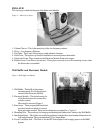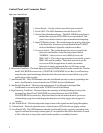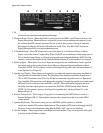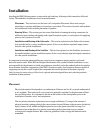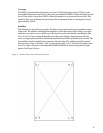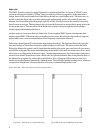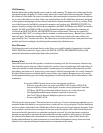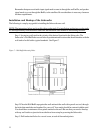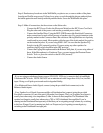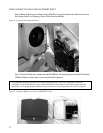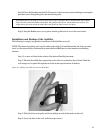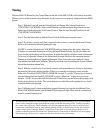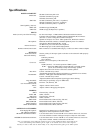
Step 4: Punchout any knockouts in the Wall Baffle you plan to use, or remove either of the plates
from the wall baffle as necessary. Pull any loose wires or cords through the chosen path and place
the baffle against the wall lined up with the predrilled holes. Screw the Wall Baffle into place.
Step 5: Make all connections, but do not turn on the Subwoofer.
- Connect the IEC Power Cord to the Electronic Module at the IEC Power Cord Jack.
- Plug the other end of the power cord into the grounded power socket.
- Connect the Satellite Wires. Using the INCLUDED removable Euroblock Connectors
make connections for each of the four runs of speaker wire. Pay special attention to the
polarity marked on the Connector Panel. Be consistent. Having Satellites out of polarity
could result in poor sound. Most speaker cable has one of the leads marked for positive
on the insulation jacket. If you are using SMS1-SAT’s be sure that the Speaker EQ
Switch is in the ON (outward) position. If you are using any other speakers for
satellites, the EQ switch should be in the OFF position.
- Connect the Paging Microphone and/or the Remote Wall plate, if you are using either of
these. If the Microphone is a Condenser Type, you must engage the Phantom Power
Switch. To do so, press the switch so that it is ON (inward).
- Connect the Audio Source
-If you are using an unbalanced stereo source (CD, DVD, VCR, etc.) connect to the Left and Right,
Unbalanced RCA Jacks. NOTE: DO NOT run an unbalanced cable longer than 16 ft (5 m) into this
input. Doing so will pick up noise and result in degraded fidelity.
- For a Balanced Stereo Audio Signal, connect (using the provided block connectors) to the
Balanced Audio inputs.
-For a Speaker Level Signal (from an amplifier or Distribution line) connect (using the provided
Euroblock connectors) to one of the pairs of Speaker Level inputs. The Low-Z speaker level input is
usually best when using a low impedance (2 ohm, 4 ohm or 8 ohm) amplifier. The Distributed Line
speaker level input is usually best when using a 70V or 100V distributed line amplifier. If you’re
running into the Distributed line input and you find that you’re not getting enough volume, try switching
to the Low-Z input. If you’re running into the Low-Z input and you’re getting too much gain, try
switching to the Distributed Line input jack.
12



